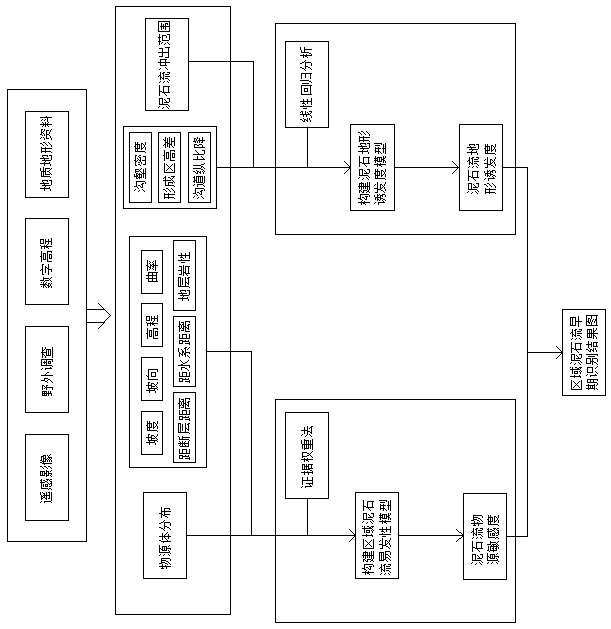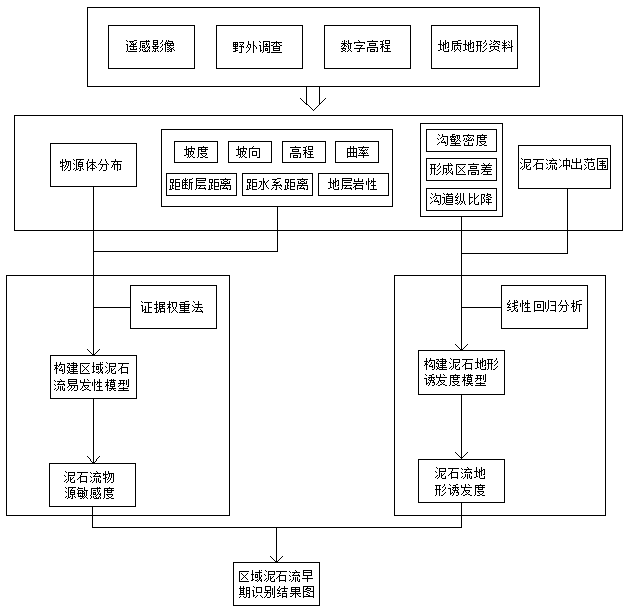Post-earthquake debris flow early recognition method
An early identification and debris flow technology, applied in the early identification field of post-earthquake debris flow, can solve the problems of not being able to identify post-earthquake debris flow disasters, not taking into account the characteristics of source changes, and not being able to monitor and prevent post-earthquake debris flow disasters, etc.
- Summary
- Abstract
- Description
- Claims
- Application Information
AI Technical Summary
Problems solved by technology
Method used
Image
Examples
Embodiment 1
[0033] An early identification method for post-earthquake debris flow, comprising the following steps:
[0034] a. After accurately interpreting the provenance of remote sensing images, determine the evaluation factors, and grade the evaluation factors through the spatial analysis function of the geographic information system. According to the selected evaluation factors, count the area occupied by each evaluation factor under different classifications, and select the evidence The weight method is used to calculate the prior probability P under each classification P(m) and the posterior probability P (m) , the prior probability P P(m) Determined by formula 1, the posterior probability P (m) Determined by formula 2;
[0035] P P(m) =a i / A Formula 1
[0036]
[0037] Among them, P P(m) is the prior probability, which means that the unit area of 1km is randomly selected 2 Probability of debris flow occurring above; P (m) is the posterior probability, indicating the...
Embodiment 2
[0045] An early identification method for post-earthquake debris flow, comprising the following steps:
[0046] a. After accurately interpreting the provenance of remote sensing images, determine the evaluation factors, and grade the evaluation factors through the spatial analysis function of the geographic information system. According to the selected evaluation factors, count the area occupied by each evaluation factor under different classifications, and select the evidence The weight method is used to calculate the prior probability P under each classification P(m) and the posterior probability P (m) , the prior probability P P(m) Determined by formula 1, the posterior probability P (m)Determined by formula 2;
[0047] P P(m) =a i / A Formula 1
[0048]
[0049] Among them, P P(m) is the prior probability, which means that the unit area of 1km is randomly selected 2 Probability of debris flow occurring above; P (m) is the posterior probability, indicating the ...
Embodiment 3
[0058] An early identification method for post-earthquake debris flow, comprising the following steps:
[0059] a. After accurately interpreting the provenance of remote sensing images, determine the evaluation factors, and grade the evaluation factors through the spatial analysis function of the geographic information system. According to the selected evaluation factors, count the area occupied by each evaluation factor under different classifications, and select the evidence The weight method is used to calculate the prior probability P under each classification P(m) and the posterior probability P (m) , the prior probability P P(m) Determined by formula 1, the posterior probability P (m) Determined by formula 2;
[0060] P P(m) =a i / A Formula 1
[0061]
[0062] Among them, P P(m) is the prior probability, which means that the unit area of 1km is randomly selected 2 Probability of debris flow occurring above; P (m) is the posterior probability, indicating the...
PUM
 Login to View More
Login to View More Abstract
Description
Claims
Application Information
 Login to View More
Login to View More - R&D
- Intellectual Property
- Life Sciences
- Materials
- Tech Scout
- Unparalleled Data Quality
- Higher Quality Content
- 60% Fewer Hallucinations
Browse by: Latest US Patents, China's latest patents, Technical Efficacy Thesaurus, Application Domain, Technology Topic, Popular Technical Reports.
© 2025 PatSnap. All rights reserved.Legal|Privacy policy|Modern Slavery Act Transparency Statement|Sitemap|About US| Contact US: help@patsnap.com



